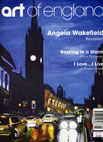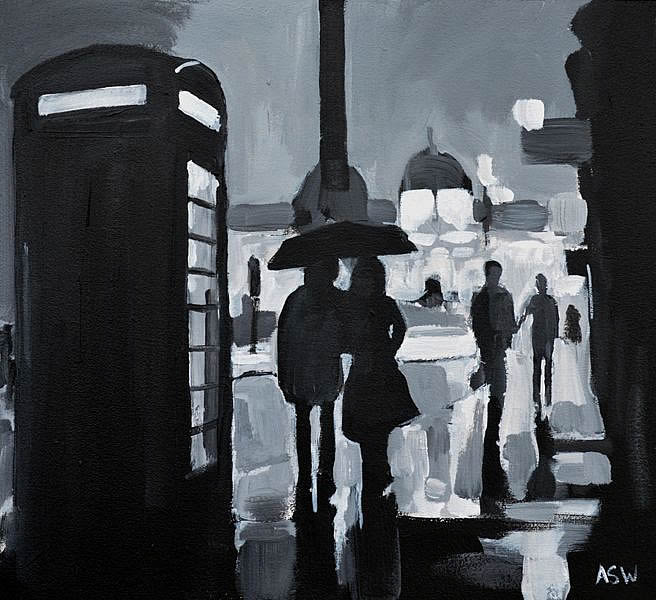Angela Wakefield Revisited – (June 2010) in the Art of England Magazine
Ian Welland returns after three years to interview the brilliant urban artist Angela Wakefield and assesses her latest work, inspiration and direction….
In viewing and assessing urban artist Angela Wakefield, I can only describe her work as having total integrity. It is real, experienced and ensures there is no confusion. In many ways it fixes us to the everyday, but, in other ways, her work allows us to breathe occasionally and move the scenario from canvas to dialogue. It is this movement and the association of the realism with contextual meaning that first captured my senses fully in 2007 when I visited the artist at her studio.
 So where is Angela today and, moreover, where is she heading and what continues to inspire her? Whilst assessing a batch of her latest work, I took the opportunity to speak with the artist again…
So where is Angela today and, moreover, where is she heading and what continues to inspire her? Whilst assessing a batch of her latest work, I took the opportunity to speak with the artist again…
Have you made any changes to the way you work?
Yes. I think I am painting a wider range of locations and taking on bigger challenges. Basically, I want to paint more of Britain, evolve as a painter and further develop my style. If an artist sticks to one subject or working method, there is a danger of stagnating, and I will never do that. Recently I have been working in collaboration with Steve Highfield & Ed O’Keeffe who have provided me with some incredible photography as reference material.
I continue to see a positive appliance of colour throughout. The acrylic provides you with flexibility that is backed up with confident strokes on canvas. Have you considered or experimented with other mediums; one thinks of the effect achieved with Oldham Street?
The acrylic medium suits the spontaneous way in which I like to work at present, and I love painting in diluted acrylics, as I did with Oldham Street, a method that helps me be more instinctive as a painter.
Your subject matter continues to combine industrial backdrops within urbanisation. Does this remain vitally important?
It’s what I know; it’s what inspires me and it’s intrinsic to my artistic message. I like to paint other subjects, but it is the combination and interaction of architecture, lights, traffic and people that provide an exciting and attractive subject matter for me to paint.
Your work creates mood, tension, and is underlined by an evolving narrative, often provided by the viewer. What is your view during the execution stage and when you see the final finished work?
This mood is sometimes created as I paint; a narrative is always running through my head, and this clearly translates onto the canvas. I have an idyllic vision of the world and I am aware that I try to project this positivity onto the viewer, but I never lose sight of the reality.
Your work, as predicted, is becoming very collectible. Why do you believe your subject matter strikes such a chord?
My work speaks to people on a number of levels. As an abstract arrangement of colour and form, it has an initial aesthetic appeal. However, as you say, there are deeper contextual meanings included in my paintings and I think it is this deeper sense of reality that strikes a chord and resonates with people. As an artist it is always refreshing to know that one’s work is being appreciated, and strangely reassuring that it is becoming valued in the scheme of things – one of my paintings sold in 2007 for £1500 has recently had an amazing offer of over £7000!
Your work has been and continues to be exhibited widely. How do you approach an exhibition and what decisions do you make to showcase your work?
My theory is to try to keep quality high. For me, exhibiting is not just about the quantity of work you can get out to galleries. I want the galleries to like my work, understand it, and enjoy the experience of exhibiting it to an appreciative audience. It is vital to build up professional relationships and I am particularly keen to work with leading independent galleries. Ascot Studios in Lancashire will always be home, of course, but it is really encouraging to be working with a growing list of galleries that now include Blandford Fine Art in Cumbria, Mooch Art in Manchester, and Webbs Fine Art of London.
You have produced an incredible body of work. Do you have selected works in mind that you relate to particular points in your career?
Chip Shop is the obvious one. It says so much about life in the north of England, the sense of community and the nostalgia. There are others of course and no doubt you will identify some of these as a leading critic of my work.
Manchester and other locations in Lancashire dominate, but I understand that you are considering looking at Edinburgh for a new body of work?
Manchester is a city I love. The north of England is vitally important to me and has always been a source of inspiration for my work. Other locations such as London, Edinburgh, York, Durham and Cambridge are just a few of the new locations that present new challenges and underline my intention to paint a positive picture of Britain today.
Do you see your work moving in other new directions?
Possibly, bearing in mind that I have been painting seriously for over eleven years and where I am now is a consequence of continually developing as a painter. If artists stagnate and refuse to evolve, then they’re in trouble. I am not the same person I was eleven years ago and therefore I am not the same artist. I am honest enough to change my painting as my outlook on life changes, and as I develop as a human being.
As we enter a new phase of regeneration in our towns and cities, how do you see things evolving? Do you consider that there will always be the combination of the old and new i.e. reality versus vision?
In previous artistic statements I have spoken of the fairgrounds that our cities are – places of adventure, fun, and diversity – an array of elements existing in harmony. Without wanting to seem naively idyllic or pretentious, this is how I see the world. Part of my aim as an artist is to capture an enduring vision of the rapidly changing landscape of our time.
These are exciting times for Angela as an artist. The breaking out of the box has taken place and Britain is waiting to receive. The list of new locations presents a mouth-watering prospect for both artist and audience. The evidence of Angela placing all senses onto canvas is astounding and there is no reason to assume this will be lost as a result of venturing to pastures new.
Standing back to view her work, the first thing I am always struck by is the truth. Angela speaks of an alternative reality — in fact the truth is the alternative reality to what our eyes and mind wish to see. We wish to see beauty in all things almost through rose-tinted glasses, but we forget our townscapes and city centres are not always idyllic. Angela’s work reminds us clearly that the idyll is what is contained therein —the noise, the activity, the people, the place, the function. I can see change in Angela’s work that is very appealing, but importantly loses none of the vibrancy of her earlier work.
Oldham Street (acrylic on canvas, 2009), sold recently, is a remarkable painting. It closes in on the action; it is immediate in terms of our senses reacting. Angela has captured the glorious active north — a hustling bustling metropolis and there is no getting away from the architectural tiring townscape. It retains the reality of demise. In contrast, Manchester Light Trails (acrylic on canvas, 2010) brings forth a vibrant glow of progress highlighted with blue rays and an interacting neon feverish night time economy. A further interesting juxtaposition for this painting is Lake Road, Ambleside (acrylic on canvas, 2009). Both paintings tackle functionality: in the case of Manchester the feeling is fast, furious and young; in Ambleside it is the complete opposite! And here we have reality meeting us head-on. The reflections seen in both are exactly aligned to the characters of the locations but with differing people, and yet there are economic similarities.
Changes in location and the forthcoming work will confirm Angela as a leading painter of our time. Already there are rewards. Consider Rochdale Canal with Salford Quays at Night (both acrylic on canvas, 2009) and Victoria Embankment, London (acrylic on canvas, 2010). These are three of Angela’s greatest works and are all capturing sound, vision and spiritual balance. The imposing Beetham Tower in Manchester, that lofts high above the industrial revolution’s first modal transport system, is vital in depicting the chronicle of change; whilst Salford Quays at Night explores a rather romantic outlook on a calm sultry evening — the park bench waiting for lovers to overlook the major city whilst they overlook each other — it could be New York, Paris or Manchester there remains the traditional homely even Vienna. In London the light and treatment by the artist changes. Angela brings forward that well trodden path to Westminster as if the sculptural lamp is not enough testimony to London’s elevation as the key capital. Correctly, Angela also delivers the harshness of London as a place where riches and reputations have been won and lost. In Manchester there remains the traditional homely communal attachment and in Salford regeneration reigns. Added to the above, I must select Millennium Bridge Salford Quay (acrylic on canvas,2010) as a truly outstanding work.It is new, not only in structure but also in Angela’s light and tone selection. The abundance of blue is so naturally applied by the artist through a flowing blend as aqua meets an azure sky. The bridge’s oxide rose red overtone is awesome as it governs the space through its expanse. Rarely is perspective found so minutely accurate in paintings of townscapes. This work will stand alongside Chip Shop; Jazz Band, C1S Solar Tower Manchester; and Silhouette Street and prove to be yet another benchmark in the artist’s career
Certainly this fine body of new work, as with many of the artist’s earlier paintings, will become highly collectible.
In 2007 (Art of England, October 2007) I made the confident statement that “Angela Wakefield is a rising star of British art”. Judging her achievements over the course of her career and certainly in the last three years, taking into account the wealth of inspiration and her new direction, Angela continues to rise to new heights. Her work is, as ever, engaging and I am delighted that there is now an added ‘collectible’ element. I stand by my statement and now look forward to the next chapter.
See the full article here. Angela Wakefield’s work can be viewed at:-
Ascot Studios Contemporary Art Gallery,
Unit H, Bee Mill
Preston Road, Ribchester, Lancashire,
PR33XL.
Telephone: 01254 878100.
www.ascotstudios.com

